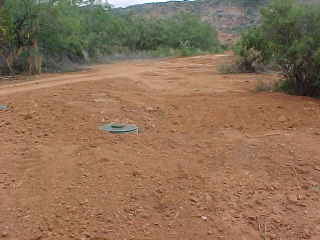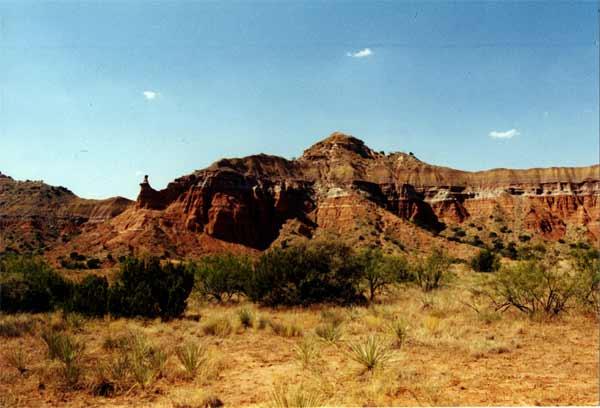 Palo Duro Canyon State Park is an expansive park located in canyon lands in the Texas Panhandle. Palo Duro Canyon is a popular tourist stop, with magnificent views in and along the canyon, and a variety of activities and points of interest in or near the park including trail and jeep rides, a visitor center with historical displays, and hiking. The park is also home to a large outdoor amphitheater where popular stage productions take place.
Palo Duro Canyon State Park is an expansive park located in canyon lands in the Texas Panhandle. Palo Duro Canyon is a popular tourist stop, with magnificent views in and along the canyon, and a variety of activities and points of interest in or near the park including trail and jeep rides, a visitor center with historical displays, and hiking. The park is also home to a large outdoor amphitheater where popular stage productions take place.
CES was retained by the Texas Parks and Wildlife Department (TPWD) to design decentralized wastewater systems to serve a number of facilities at the park, including:
- The large outdoor amphitheater, including restrooms and concession facilities;
- 3 campgrounds and one day use picnic area;
- A small outdoor interpretive area with restrooms; and
- Several RV dump stations.
Staging of design and construction was carried out based on availability of funds for the various facilities to be served. Due to the large distance between the campgrounds and the day use area, and flood prone areas between several of the campgrounds, it was determined that if sufficient land with acceptable soils could be located near the campgrounds and day use area, it would be most cost-effective to design and construct separate decentralized wastewater systems for each. Because the large amphitheater is located very near one of the campgrounds, these facilities would tie into the same large system. This system was planned and constructed prior to the other wastewater systems at the park due to the high on-going demand for its use.
Site evaluations were conducted to examine soils in potential effluent dispersal field areas near each set of facilities to be served. It was necessary to work closely with archaeological staff during the site evaluations and in all phases of the planning due to the presence of many buried historically significant artifacts known to exist in this area. Flooding issues in the canyon further confined the areas available for dispersal fields. Preliminary engineering and cost estimates were prepared for each of the planned systems, and then topographical surveys conducted for preparing final systems plans.
Several key considerations in the wastewater planning effort were the remoteness of the area, and staff and budget limitations for providing on-going operation and maintenance to the systems. Other considerations that apply to most projects of this type include limitations on available infrastructure improvement funds, and the infrequency with which those funds tend to become available. It was therefore important to utilize systems with low maintenance needs, and which would perform reliably for very long periods of time.
Based on a series of in-depth soils and site investigations, it was determined that all facilities could be served by systems utilizing septic tank pretreatment followed by low-pressure dosed subsurface effluent dispersal. Sufficient land area and depth of soil of a type suitable for this type of system was located relatively near each set of facilities to be served. Plans were prepared for each of the systems, and submitted to the applicable permitting authorities. After permits were issued for each of the systems, public bidding was advertised and carried out by TPWD. A qualified contractor was selected, and each of the systems constructed.
Below are photos for various portions of the systems constructed at the park.
 Due to the high seasonal and weekend visitation at the park, large septic tanks such as these were needed. Some of the pump tanks were also of this type.
Due to the high seasonal and weekend visitation at the park, large septic tanks such as these were needed. Some of the pump tanks were also of this type.
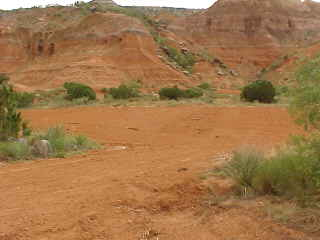 Effluent dispersal field areas were located in flatter areas near each set of facilities to be served. Shown below is an area that was cleared for use as one of the low-pressure dosing fields, and another area typical of locations selected for the dispersal fields. After construction, field areas were re-vegetated with native grasses. Areas were selected that were away from the canyon walls, and cleared for use based on flood plain information and archaeological examinations.
Effluent dispersal field areas were located in flatter areas near each set of facilities to be served. Shown below is an area that was cleared for use as one of the low-pressure dosing fields, and another area typical of locations selected for the dispersal fields. After construction, field areas were re-vegetated with native grasses. Areas were selected that were away from the canyon walls, and cleared for use based on flood plain information and archaeological examinations.
 The contractor assembled pressure manifolds and lateral line piping for each of the systems, prior to installing the piping in the field. The importance of a well-organized and experienced contractor for projects of this size cannot be over-emphasized.
The contractor assembled pressure manifolds and lateral line piping for each of the systems, prior to installing the piping in the field. The importance of a well-organized and experienced contractor for projects of this size cannot be over-emphasized.
Proper equipment is needed for the construction of decentralized wastewater systems to prevent damage to the system as the construction proceeds. Below the contractor is using a trackhoe to distribute the weight of the equipment, and avoid excessive compaction to the dispersal field area and damage to any buried portions of the system.
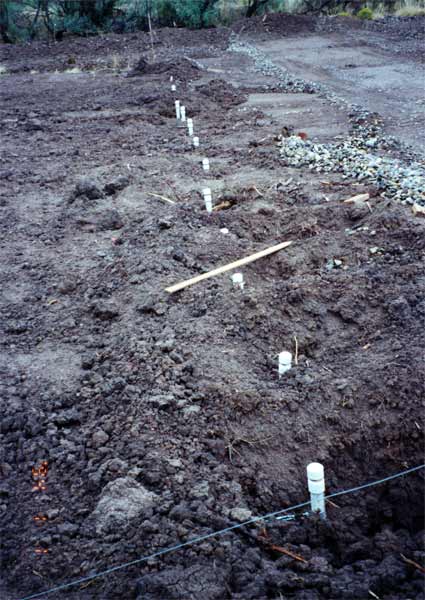 The photo of the low-pressure dosed field under construction below shows the capped ends of turn-ups at the ends of lateral lines. These will be buried only a few inches below finished grades, and can be located by park staff if necessary in the future using the metal detection tape buried at particular intervals and along certain field lines.
The photo of the low-pressure dosed field under construction below shows the capped ends of turn-ups at the ends of lateral lines. These will be buried only a few inches below finished grades, and can be located by park staff if necessary in the future using the metal detection tape buried at particular intervals and along certain field lines.
The six-port automatic effluent distributing valve shown below was needed for sequencing the pumping of effluent to six field zones at the system serving the amphitheater and Sagebrush Campground. Several of these valves were needed for the large dispersal field. Note the green metal locating tape entering the valve box used to locate the pressure manifold.
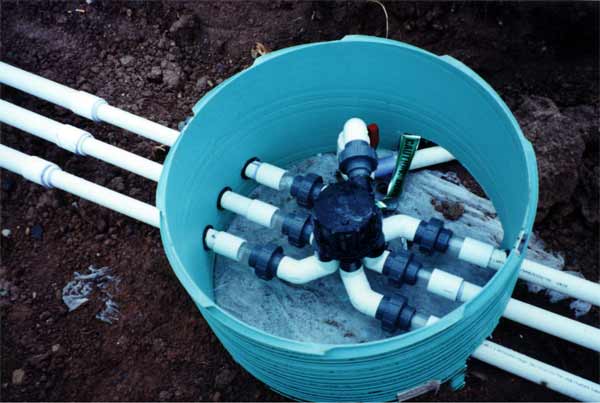
Design of the wastewater systems serving the park facilities included hydraulic analyses to determine pump and pipe sizing, as well as locations where check valves or air relief valves would be needed. Shown below is the edge of an effluent distributing valve box, with some nearby check valves used for controlling certain flow characteristics.
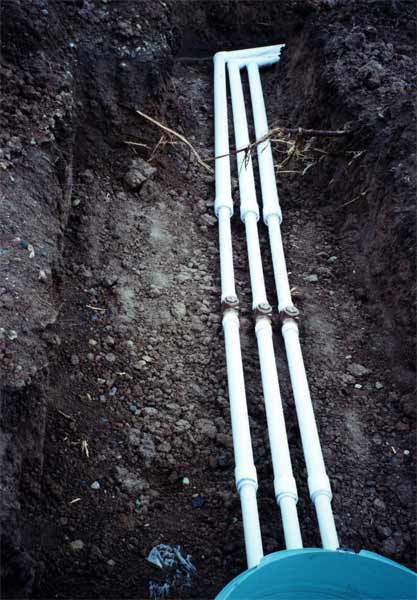 Below is a photo of a tank riser lid at the Mesquite Campground system, with final soil cover placed and prior to re-vegetation. The green watertight bolt-down tank riser lid will blend with the native grasses, but still allow easy access by park staff for inspection and maintenance of this portion of the system as needed.
Below is a photo of a tank riser lid at the Mesquite Campground system, with final soil cover placed and prior to re-vegetation. The green watertight bolt-down tank riser lid will blend with the native grasses, but still allow easy access by park staff for inspection and maintenance of this portion of the system as needed.

